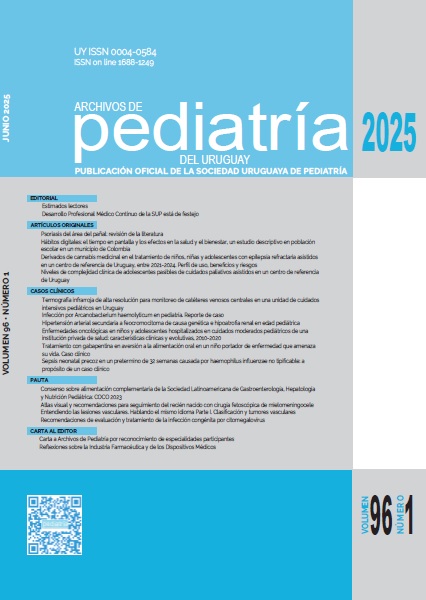Abstract
Myelomeningocele is the most common malformation of the central nervous system, associated with funcional by functional limitations and neuro-musculoskeletal, nephr-urological o nephro and intestinal complications with the consequent social and psychological repercussions on the individuals who present it. Fetal surgery with repair of the defect is, worldwide and in Uruguay, currently, the first line treatment option today. In Uruguay, almost 20 fetal surgeries have been performed with the SAFER technique. The objective of this atlas is to guide clinicians in the appropriate neonatal evaluation and treatment of patients who underwent surgery in the fetal period. A postnatal multidisciplinary approach guide for the newborn is presented with illustrative images, and recommendations on neonatological and long-term neurosurgical, neuropediatric, and urological follow-up, among others. We highlight the importance of the comprehensive, individualized and multidisciplinary assessment that these patients require to optimize surgical and functional results.
References
Dendi Á, de los Santos J, Cordobez R, Silva V, Lopéz E, Piquerez C, et al. Incidencia y características de los pacientes portadores de defectos congénitos en el Servicio de Neonatología del Centro Hospitalario Pereira Rossell 2016-2020. 5 años de experiencia. Arch Pediatr Urug 2022; 93(2):e221. doi: 10.31134/ap.93.2.28.
Sanz M, Chmait R, Lapa D, Belfort M, Carreras E, Miller J, et al. Experience of 300 cases of prenatal fetoscopic open spina bifida repair: report of the International Fetoscopic Neural Tube Defect Repair Consortium. Am J Obstet Gynecol 2021; 225(6):678.e1-11. doi: 10.1016/j.ajog.2021.05.044.
Lapa D, Chmait R, Gielchinsky Y, Yamamoto M, Persico N, Santorum M, et al. Percutaneous fetoscopic spina bifida repair: effect on ambulation and need for postnatal cerebrospinal fluid diversion and bladder catheterization. Ultrasound Obstet Gynecol 2021; 58(4):582-9. doi: 10.1002/uog.23658.
Pedreira D, Zanon N, Nishikuni K, Moreira R, Acacio G, Chmait R, et al. Endoscopic surgery for the antenatal treatment of myelomeningocele: the CECAM trial. Am J Obstet Gynecol 2016; 214(1):111.e1-11. doi: 10.1016/j.ajog.2015.09.065.
Lapa D. Endoscopic fetal surgery for neural tube defects. Best Pract Res Clin Obstet Gynaecol 2019; 58:133-41. doi: 10.1016/j.bpobgyn.2019.05.001.
Adzick N, Thom E, Spong C, Brock J, Burrows P, Johnson M, et al. A randomized trial of prenatal versus postnatal repair of myelomeningocele. N Engl J Med 2011; 364(11):993-1004. doi: 10.1056/NEJMoa1014379.
Meneses V, Parenti S, Burns H, Adams R. Latex allergy guidelines for people with spina bifida. J Pediatr Rehabil Med 2020; 13(4):601-9. doi: 10.3233/PRM-200741.
Ozek M, Cinalli G, Maixner W. Spina bifida, management and outcome. Berlín: Springer, 2008.
Lapa D, Acacio G. Protocolo de cuidados neonatais com a cicatriz da cirugia fetal. São Paulo: Hospital Israelita Albert Einstein, 2023.
Yamashiro K, Galganski L, Hirose S. Fetal myelomeningocele repair. Semin Pediatr Surg 2019; 28(4):150823. doi: 10.1053/j.sempedsurg.2019.07.006.
Alruwaili A, Das J. Myelomeningocele. En: StatPearls. Treasure Island, FL: StatPearls Publishing, 2024. Disponible en: https://www.ncbi.nlm.nih.gov/books/NBK546696/. (Consulta: 8 febrero 2021).
Au K, Ashley A, Northrup H. Epidemiologic and genetic aspects of spina bifida and other neural tube defects. Dev Disabil Res Rev 2010; 16(1):6-15. doi: 10.1002/ddrr.93.
Bartonek A, Saraste H, Knutson L. Comparison of different systems to classify the neurological level of lesion in patients with myelomeningocele. Dev Med Child Neurol 1999; 41(12):796-805. doi: 10.1017/s0012162299001607.
Bowman R, Lee J, Yang J, Kim K, Wang K. Myelomeningocele: the evolution of care over the last 50 years. Childs Nerv Syst 2023; 39(10):2829-45. doi: 10.1007/s00381-023-06057-1.
Brea C, Munakomi S. Spina bifida. En: StatPearls. Treasure Island, FL: StatPearls Publishing, 2024. Disponible en: https://pubmed.ncbi.nlm.nih.gov/32644691/. (Consulta: 8 febrero 2021).
Cavalheiro S, da Costa M, Barbosa M, Dastoli P, Mendonça J, Cavalheiro D, et al. Hydrocephalus in myelomeningocele. Childs Nerv Syst 2021; 37(11):3407-15. doi: 10.1007/s00381-021-05333-2.
Copp A, Stanier P, Greene N. Neural tube defects: recent advances, unsolved questions, and controversies. Lancet Neurol 2013; 12(8):799-810. doi: 10.1016/S1474-4422(13)70110-8.
Dias L, Swaroop V, de Angeli L, Larson J, Rojas A, Karakostas T. Myelomeningocele: a new functional classification. J Child Orthop 2021; 15(1):1-5. doi: 10.1302/1863-2548.15.200248.
Du Plessis A, Johnston M. Fetal neurology. En: Arzimanoglou A, O´Hare A, Johnston M, Ouvrier R, eds. Aicardi's diseases of the nervous system in childhood. 4 ed. London: Mac Keith Press, 2018:5-84.
Geerdink N, van der T, Rotteveel J, Feuth T, Roeleveld N, Mullaart R. Essential features of Chiari II malformation in MR imaging: an interobserver reliability study--part 1. Childs Nerv Syst 2012; 28(7):977-85. doi: 10.1007/s00381-012-1761-5.
Iftikhar W, De Jesus O. Spinal Dysraphism and Myelomeningocele (Archived). En: StatPearls. Treasure Island, FL: StatPearls Publishing, 2024. Disponible en: https://pubmed.ncbi.nlm.nih.gov/32491654/. (Consulta: 8 febrero 2021).
Pico E, Wilson P, Smith K, Thomson J, Young J, Ettinger D, et al. Spina Bifida. En: Alexander M, Matthews D. Pediatric rehabilitation: principles and practice. 5 ed. New York: DemosMedical, 2015:373-411.
Tita A, Frampton J, Roehmer C, Izzo S, Houtrow A, Dicianno B. Correlation between neurologic impairment grade and ambulation status in the adult spina bifida population. Am J Phys Med Rehabil 2019; 98(12):1045-50. doi: 10.1097/PHM.0000000000001188.

This work is licensed under a Creative Commons Attribution 4.0 International License.
Copyright (c) 2025 Archives of Pediatrics of Uruguay


